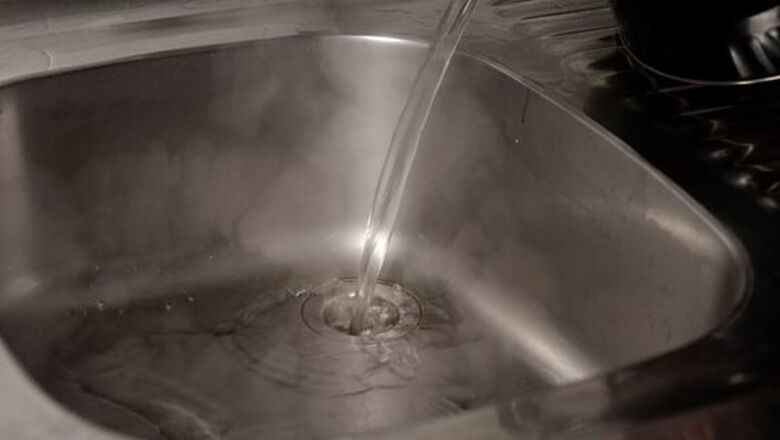
views
Using Baking Soda and Vinegar
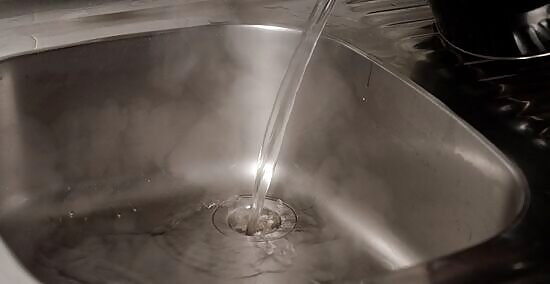
Flush your drain with boiling water. Boil a pot of water in a pot or kettle, and slowly pour it down your sink drain. The hot water will help remove any smaller particles that have built up inside the drain. While prolonged exposure to boiling water can damage plastic or PVC pipes, it’s generally safe to pour a pot or kettle down the drain since it rinses out quickly.
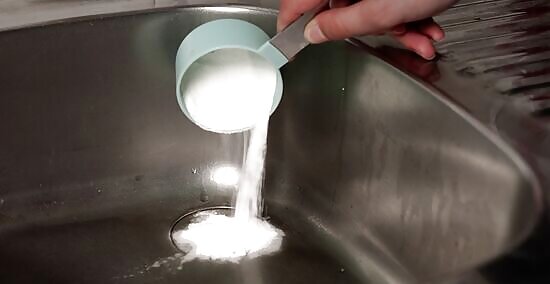
Pour 1/2 cup (114 g) of baking soda down the drain. Remove the sink stopper if your drain has one. Slowly pour the baking soda directly into the drain and let it sit for a few minutes to absorb smelly odors. Baking soda and vinegar work great for cleaning bathroom sink drains as well as kitchen sink drains, including your garbage disposal.
Pour 1 c (240 mL) of distilled white vinegar down the drain. Professional cleaner Kadi Dulude recommends pouring the vinegar directly on the baking soda to create a chemical reaction. The baking soda will start to fizz and bubble as it starts reacting with the vinegar. In a pinch, you can use apple cider vinegar in your homemade sink drain cleaner instead. Green cleaning expert Susan Stocker suggests that 1 c (240 mL) of vinegar alone may be enough to clear clogs and debris. She says, “Let it sit for 30–40 minutes. [Vinegar] has a very high acid content, and will break down a good bit of organic content that is stuck.”
Allow the mixture to fizz in your drain for 10–15 minutes. As the baking soda and vinegar react to each other, the solution will work its way down your drain to remove potential clogs or buildup. Kadi Dulude, a professional home cleaner, notes that vinegar and baking soda can also clear minor clogs and remove odors from smelly sink drains.
Flush your sink one last time with boiling water. Boil another pot or kettle of water and slowly pour it down the drain to wash out the remaining baking soda and vinegar. The hot water will also remove any loosened buildup still left in the drain. If you still see buildup or if your drain is still smelly, try using the baking soda and vinegar again to clear it up. Bridgett Price, a professional home cleaner, recommends pouring an orange-based cleaning solution down the drain to add a pleasant smell. She says, “It creates that nice scent that permeates throughout the room…it just perfumes the air, and it’s pretty lovely.”
Using Boiling Water and Soap
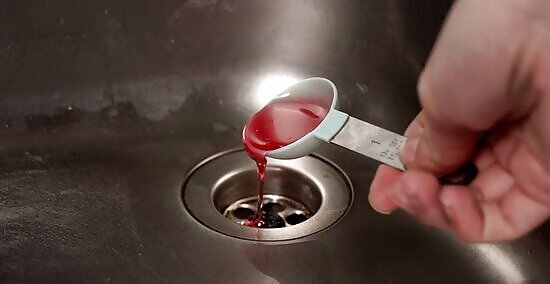
Put 1 US tbsp (15 ml) of dish soap down the drain. Any liquid dish soap works, so choose your favorite scent. Pour the soap directly into the sink drain so it coats any buildup and debris. Liquid dish soap works best at cutting through grease and oils in your kitchen sink, but it effectively cleans bathroom drains too.

Pour boiling water slowly into the sink to wash out debris. Boil water in a pot or kettle and pour it directly into the drain. The hot water and dish soap combo will help dissolve stuck-on debris, so it will break apart clogs and remove bad odors. If your drain pipe is still clogged or if it smells, try the soap and boiling water mix again. If it still doesn’t work, try another way to unclog the drain.
Best Ways to Clean a Garbage Disposal

Unplug the disposal and pull out debris with needlenose pliers or tongs. Start by unplugging your garbage disposal or turning off the fuse it’s connected to. Shine a light into the disposal to look for any large debris. If you see any, use your pliers or tongs to fish it out. Never put tools or your hands inside the garbage disposal while it’s plugged in because you could seriously injure yourself.

Run borax and hot water through your disposal for a quick clean. Sprinkle 2–3 tablespoons (51–76.5 g) of borax directly into your garbage disposal and leave it to sit for about 15 minutes to absorb odors. Then, run hot water from your faucet, and turn on your garbage disposal to clean out debris.

Grind ice cubes and salt in the disposal to scrub the insides. Take a handful of coarse salt and a few ice cubes, and drop them inside of your garbage disposal. Run cold water and turn on the disposal to break apart the ice. The ice helps knock food debris off the grinder and the salt acts as an abrasive to scrub the interior parts. If your garbage disposal is really smelly, drop in a few lemon peels and turn the blades on. The peels will leave behind a fresh citrusy scent after they’re broken apart.
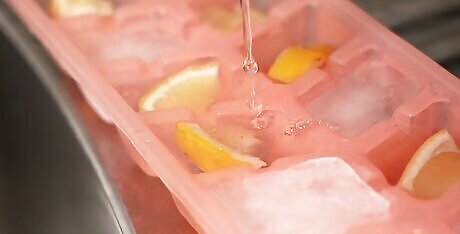
Make lemon and vinegar ice cubes to clean and deodorize. Cut a piece of lemon into individual slices that are small enough to fit into each section of an ice cube tray. Fill the tray with distilled white vinegar and put it in your freezer. Once the cubes are solid, put them into your garbage disposal, and turn it on while running cold water. The ice will scrub the insides of your garbage disposal, and the lemon and vinegar will neutralize odors. Cold water hardens oils and grease so that the garbage disposal blade can break them up. If you use hot water, the grease and oil may solidify deeper in your pipes and require a professional plumber to remove.
Best Ways to Remove Clogs
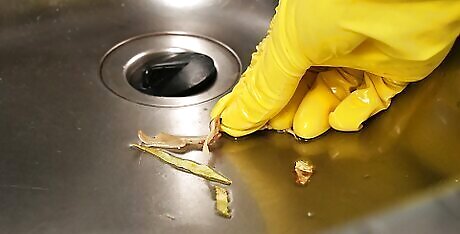
Pick out debris around the stopper by hand. If you can see visible buildup and debris around the drain stopper, put on a pair of rubber cleaning gloves and try to pick the pieces out by hand. Remove the stopper, and wipe the inside of the sink drain with a paper towel to clear out as much gunk as you can.

Run a snake through your drain to remove buildup. Drain snakes are long plastic or metal pieces that pull debris out from your drain pipes. Feed the end of the snake into your drain and gently push it until you feel a blockage. Quickly move the snake up and down to break apart the debris and unclog your sink. If you don’t have a drain snake, professional cleaner Kadi Dulude recommends straightening a wire hanger and gently pushing it down the drain. She says, “You can make a hook at the end of the wire to pull up any hair that’s stuck in the drain.” David Balkan, a professional plumber, warns that drain snakes could go through a drain line or get stuck if they’re used improperly. He recommends having a plumber snake your drain if you don’t feel confident doing it yourself.
Use a sink plunger to break apart the clog. Professional plumber David Balkan says to put water in your sink before using a plunger to help force the blockage out. Place the plunger cup over the drain and swiftly move the handle up and down to push the clog out of your pipes. Avoid using the same plunger for your toilet and your sink because you could spread bacteria.
How often should you clean a sink drain?
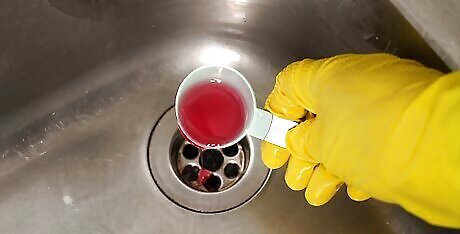
Clean your drain either weekly or monthly. If you notice some debris or bad smells coming from your sink drain at the end of the week, quickly clean it to prevent any further buildup. If your sink looks fine, then you can get by with cleaning out the drain about once a month. Schedule a professional cleaning once a year with a plumber to help remove buildup in your pipes that you’re unable to reach.
Keeping Your Sink Drain Clean
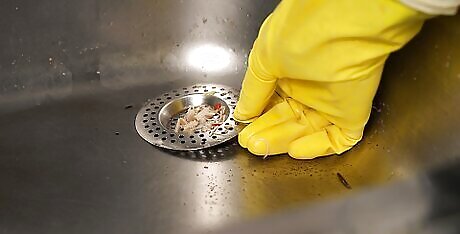
Keep grease, coffee grounds, and hair out of your drain. Drains commonly clog up and develop odors when solid debris gets caught in the pipes. Avoid putting solid foods, hair, coffee grounds, grease, or any other foreign objects down your drain so it can stay clean. If you need to get rid of cooking oil, collect it in a glass jar after cooking and throw it away in your garbage. If you are shaving over the sink, line the basin with paper towels or grocery bags to catch the hair before it goes down your drain.
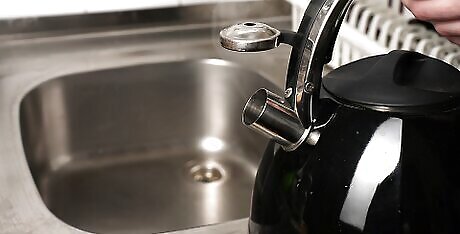
Rinse your drain with hot water after you wash your dishes. If you clean your sink basin or wash dishes, run hot water from your faucet or boil a pot of water to pour down the drain afterward. The water can flush out any soap or debris from your drain pipes to prevent odors and clogs from forming.
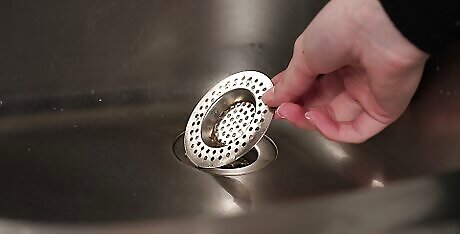
Put a mesh screen over your drain to catch debris. Set the mesh screen over your drain so food and other debris can’t wash into the drain pipes. When the mesh screen is full of gunk, take it out and empty it into your trash can.













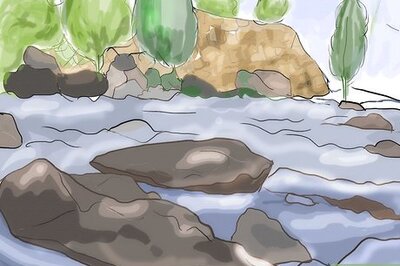


Comments
0 comment